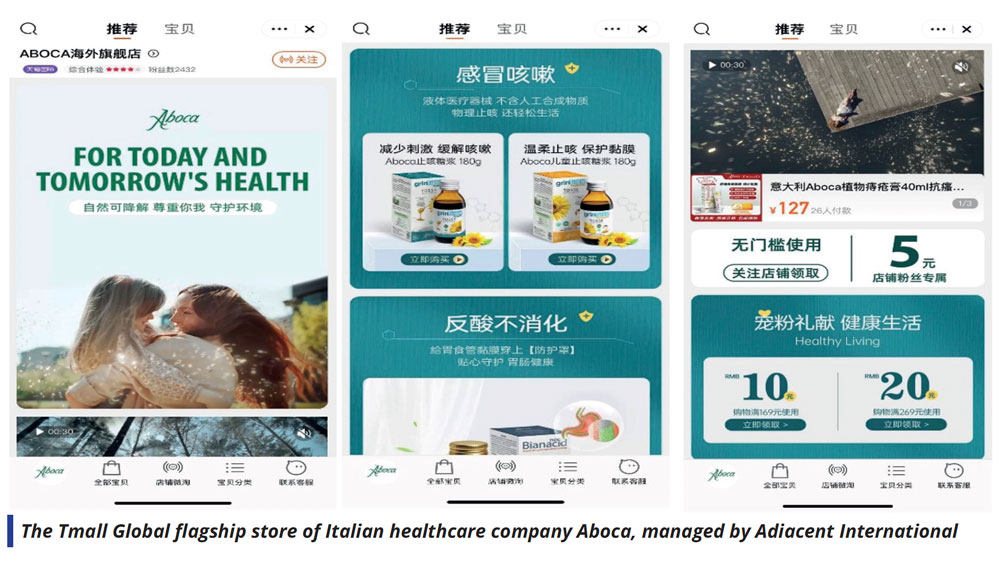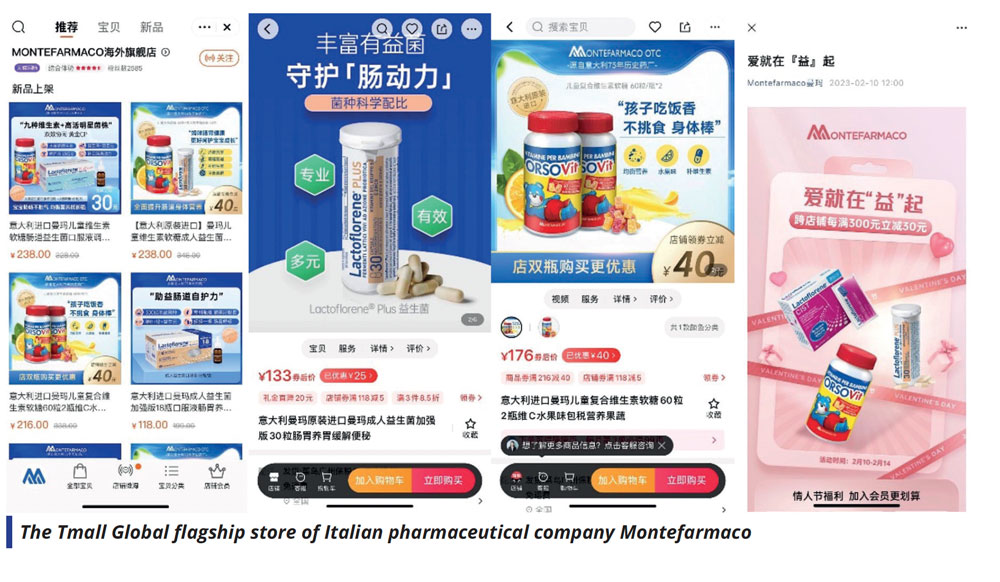



Adiacent International is your global digital business partner. It is the international business unit of Adiacent that counts 350 people and 13 offices in Italy, China, APAC, USA and Mexico, with a turnover of EUR 30 million in 2022. Together with Var Group, Adiacent is part of Sesa Group which has been listed on the Italian Stock Exchange since 2013. Sesa is a leading distributor of ICT solutions and has a revenue of about EUR 2.4 billion (as of April 2022). Find out more on Adiacent’s website.
With over 50 specialised resources focusing on the Chinese market in Shanghai, we are the leading digital Italian company for China. We offer a mix of services including:
Brand development
Our brand-centred approach helps companies find their voice, target, and message in China and expand it through marketing actions. We manage all marketing activities such as digital social media and digital media placement.
Digital supply chain and e-commerce
We operate e-commerce stores on all China’s digital channels and develop digital B2B commercial networks for brands in the market. We are a tech 3PL and we integrate logistics solutions for the effectiveness of our customer’s supply chain.
Technology and innovation
We develop in-house tech solutions and we own Sparkle, a patented management platform to connect global platforms with China’s unique digital ecosystem. Sparkle can act as middleware as well as ERP, OMS and CRM tool to quickly deploy e-commerce and marketing activities in China.
Among our clients, small and medium-sized EU brands frequently seek assistance in entering the Chinese digital market through cross-border e-commerce (CBEC). CBEC allows brands to sell the products in China without having to obtain a Chinese business license, so goods can be easily sold from overseas. It thus enables brands with smaller investment capabilities to enter and test the Chinese market potential.
The very first step is to make a comprehensive digital assessment. We need to know if the brand is already present through official digital channels (social media and e-commerce), and if so, which ones. We also have to understand if some products are already sold by some retailers, and if so, at what price. Finally, we need to make a full assessment of the perceptions of the brand among Chinese consumers.
The next step is to conduct in-depth research of the relevant market, as well as the main players and competitors. On this basis, we develop a market entry strategy to maximise the brand’s potential in the Chinese market. Although CBEC allows for easier import procedures compared to general trade, it is essential to verify the import and sales feasibility. Once the client confirms the operational plan, we officially start operations.
As a successful case, we want to introduce Aboca. Aboca is an Italian healthcare company that develops 100% natural and biodegradable products. Most of Aboca’s products are identified as medical devices by the Ministry of Health. As medical devices are intended for use in humans for the purpose of diagnosis, prevention, control, therapy, or alleviation of disease, belonging to this category demonstrates the effectiveness of the products. It also distinguishes the products from other ones that have different intended use, such as health supplements or herbal preparations.

As indicated before, CBEC is most effective to overcome long, complex procedures needed to import the products via general trade. Thus it is not a coincidence that the most popular categories for CBEC are cosmetics and health supplements. However, medical devices still need to follow special requirements. This aspect really made the project interesting, in particular at the first stages. For instance, assessing the viability of the product in the Chinese market was slightly more complex to open a flagship store on Tmall and store the goods in a specific warehouse. We had to consult a legal advisor to make an in-depth analysis of the products’ efficacy claims that we could use in marketing activities, as these must fully abide by Chinese laws and regulations.
This preliminary work was costly and time-consuming, yet necessary for medical devices to enter the Chinese market, even via CBEC. Chinese consumers perceive the products as high-quality items. Even though the store only opened in September 2022, we can already see good signals in sales performance.
Another successful case that we would like to present is Montefarmaco: an Italian family-
operated pharmaceutical company, market leader in probiotics and kids Vitamin Supplement in Italy. In 2019, Montefarmaco launched a mono-brand flagship store on Tmall Global. After a first year of optimising performance and consolidating the products most appreciated by Chinese consumers, the brand decided to strengthen its B2C and B2B marketing activities together with Adiacent China. It aimed to achieve a tenfold growth in high-quality selective distribution. Since 2020, multiple retailers have contacted the brand for the promotion and sales of the products. Currently, OrsoVit, Lactoflorene line products are sold on Tmall, JD, WeChat Store and many highly specialised Chinese online pharmacies, including “Ali-Health”, Alibaba-owned and operated pharmacy.
The cross-border project in China has allowed Montefarmaco to make certain lines of products that are market leaders in Italy accessible to Chinese consumers. The opening of the flagship store and the digital marketing activities have allowed the development of an online distribution network which has favoured the correct positioning and marketing of the products. The B2C model has been the gateway to the development of multi-channels.
One of the most frequent issues that we see relates to wrong expectations in terms of resources actually needed. Even if CBEC is, overall, a less costly approach to enter the Chinese market, at least compared to general trade, it still requires a significant amount of resources and time to succeed. This is especially true if a brand is not known among Chinese consumers and its products are not already available through digital channels. Consistent marketing activities are then needed to increase awareness and desirability. Internal marketing is not enough to succeed on the Chinese marketplace, which already hosts thousands of international brands. Brands need to create their own identity and spread their voice to stand out from the crowd.
Furthermore, even though some may associate CBEC with high-volume existing traffic, brands need to take into account costs related to security deposit, commissions, and management fees. Alternatively, brands can consider to create their own platform. For example, they can develop an external website converted in a mini-program with e-commerce functionalities on WeChat. This allows brands to have full control and flexibility. On the other hand, marketing activities need to be done in house, which can be time and cost consuming. Besides, companies also need to manage independently the logistics and payment gateway.
Allocating resources for certain activities, such as KOL and KOC seeding activities, and then suddenly reducing the investment for external marketing activities, is one example of things to avoid. This will result in lack of brand awareness and visibility on the Chinese digital channels. As a consequence, brands will see low sales performance. As a digital agency, we provide the client with several suggestions and plans for marketing investment, both internal (advertising activities within the e-commerce platform) and external (social media, KOL/KOC/media buying etc). The client needs to be fully aware and committed to allocate the necessary budget.
Other issues to mention relate to not being able to go the extra mile and falling short of initial expectations. This is especially true for cosmetics and healthcare products. If they obtain certifications on therapeutic claims, this can have an enormously positive impact on raising the image of quality and positioning of the brand in the Chinese market. Of course, this requires significant efforts, but these will pay off in the long term from increased sales performance.
Another frequent mistake is to get stuck in price wars. Newcomers to the Chinese market often attempt to win customers by offering substantially lower prices via discounts or coupons. Many, however, will eventually fail to generate the cash flow required to sustain this discounting strategy on the long term.
CBEC may be the right way to enter the Chinese market for all small EU brands that do not have business license in China and are not planning to do it, or have smaller budget to invest (compared to general trade). CBEC is also an effective way to test the Chinese market and obtain useful feedback. This can contribute to future decision-making on entering via general trade.
In terms of products to place, we usually do not recommend to place one product only. We ask the brand to share detailed insights and explanation about the company and each product’s USP. This allows us to assess the potential of each product through market research. Although it depends on specific product categories and strategies, in general, we make a shortlist of about 5-10 products. Among these, we highlight 1 or 2 that should be positioned as “product hero”.

In terms of budget, a detailed Profit & Loss document is carefully prepared to understand and analyse the fixed and variable costs (platform, logistics, COGS, TP fees, marketing, etc.). We also measure the expected GMV performance based on the list of products and suggested retail price, taking into consideration discount and promotion activities. The P&L is developed for a time horizon of 3-5 years. Upfront costs and investments are high at the beginning. The first year is rarely profitable; the second year may see brands break even.
Finally, we have observed the saturation of many market segments, especially in cosmetics and health supplements. Therefore, brands need a strong, coherent and multi-layered plan and strategy to differentiate themselves in the market and get a precise positioning. Chinese consumers look for specific and high-quality products in the CBEC sphere. Brands need to communicate on their history, formulas, ingredients and create storytelling.
In our experience, the most successful brands selling to China via CBEC are cosmetics and beauty products, baby products and health supplements.
The purchase and delivery procedures of imported CBEC products take longer than for general trade products. Chinese consumers need to enter their personal ID card details and the products have to go through custom clearance. So there must be a solid reason for Chinese consumers to accept this longer procedure:
The first reason is to purchase specific, high-quality products that cannot be found elsewhere. In general, Chinese consumers perceive foreign brands as having genuine products and a higher quality than those that are widely available and common.
The second reason is the price, which may be lower for products imported via CBEC rather than general trade. CBEC regulations allow the sale of many category of products without import tariffs or at a lower sales tax rate. In practice, this may result into a considerable difference in price, when compared to the same product regularly imported.
The third reason is availability. CBEC offers a wider variety and greater choice of products that may not be available in offline retail. This is particularly true for organic products, which are highly complicated and expensive to certify for import.
All these reasons should help EU brands to build and develop the proper strategy to enter the CBEC market. Differentiating by offering a specific, high–quality and hard-to-get product that make Chinese consumers feel that they get something special. The way to succeed is to differ from the products that they can find in the local marketplace.
Furthermore, the market is highly competitive. Brands need exceptional digital marketing activities to stand out from the crowd and increase brand awareness. Localisation and content adaptation are essential. It requires greater commitment than simply adjusting to suit local tastes. Chinese consumers enjoy a seamless path from the brand discovery to purchase. Brands should invest to create sophisticated content, campaigns, channels and different touch points along the customer journey.
In short, to be successful via CBEC, brands need to be able to offer a particular product. It should be something special that can move Chinese consumers away from the local marketplace. The latter has a wide offering of products perceived to be less genuine (for general trade imports) or at lower price (local brands).
2022 may have been the worst year of economic growth for China. But there are expectations that the Chinese economy could recover faster than expected.
With the end of travel restrictions, international travellers will be ready to travel again to China. This should bring back optimism about the country’s development as well as its manufacturing and supply chain strengths. Meanwhile, the shopping behaviours of Chinese consumers have changed: they are more sophisticated than ever. Consumers are keen to spend money in areas that will improve their quality of life (health, beauty, sports, education). They pay attention to the quality of the product/service. For this reason, they don’t automatically favour foreign brands over local brands. Foreign brands need to focus on their strategy to succeed in the market.
Chinese tourists can also go back to foreign countries, generating revenue and opportunities. Currently, they are still cautious and may prefer
destinations that prove more welcoming to China, such as Southeast Asia and European countries.
Do not underestimate costs. Determining the right retail price is essential. Brands have to take into account the product’s and potential price war with competitors. It should also consider all other relevant costs such as VAT, customs fees, and delivery fees.
Sellers can ship directly to Chinese consumers from overseas. However, warehouses within Chinese bonded zones provide a much faster logistics option. This improves the customer experience for the Chinese consumers used to receiving products in a very short time.
As always, make sure to prepare a strategy with clear objectives. Marketing and advertising are indispensable. That said, budget needs to be sufficient and well allocated, both internally and externally of the platform. Only in this way can brand attract Chinese consumers’ attention and drive traffic to the store.
Brands should proactively ask the support of professional CBEC partners like Adiacent International. We specialise in the whole range of e-commerce operations. We provide 360-degree support to brands, from strategy, e-commerce operations, marketing, tech, supply chain and regulatory support. The main difference between Adiacent International and traditional Chinese distributors is the close relationship that we establish with our clients. It is an all-round partnership with brands. We work together to find the right key to enter the market. To do this, we need the support and expertise of the brand. These help us gain a deep understanding of its values, core products, and products’ unique selling point. This approach puts us apart from traditional distributors, who purchase goods from a supplier and resell them to local-end users. Here is a list of activities we develop for brands:
For instance, for online stores: brands fully owned the stores. Adiacent International only manages operations. We come to an agreement on the product selection, price, strategy, and marketing allocation. We share regularly with our clients the sales and return reports, as well as marketing performance reports and stock reports.
Adiacent International is the Italian digital leader in China. Our CEOs and several team members are Italian so we can be really close to the brands, even in person. The team in China has over 50 local talents who provide the necessary expertise to support in depth the brands entering the market. This really makes us different.
Read our 2023 report on Cross-Border E-Commerce, with an English translation of the CBEC Positive List, for practical advice and an overview of regulations.